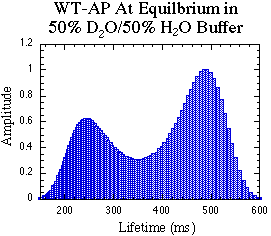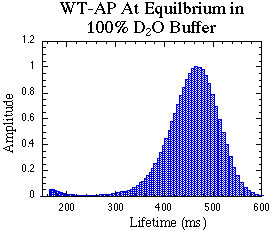How Many Residues Must Exchange To Affect The Lifetime?
Hydrogen exchange is a dynamic, reversible process and deuterated
sites can become reprotonated, depending upon the relative concentrations
of protons and deuterons in the solution. If n hydrogens need to be exchanged
to affect the lifetime then the probability of all being exchanged at equilbrium
would be the nth power of the relative percentage of D2O
in the solution. When experiments were conducted in 50% D2O
and 50% H2O two lifetimes were present
at final equilibrium and each lifetime accounted for 50% of the observed
phosphorescence [Figure 5, below]. This is consistent with the idea that
it is the exchange of a single, specific hydrogen which is affecting the
phosphorescence lifetime.

Figure 5a: MEM distribution analysis of the lifetime of
WT-AP at 50 °C in 50% H2O/50% D2O
buffer. Both peaks have the same area. and thus equal contributions to
the total lifetime.

Figure 5b: MEM distribution analysis of the lifetime of
WT-AP at 50 °C in 100% D2O buffer.
The presence of only one peak in the distriubtion indicates one lifetime.
Activation Energies For D2O Exchange